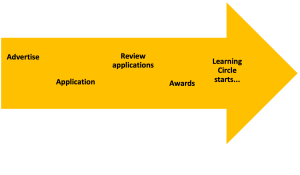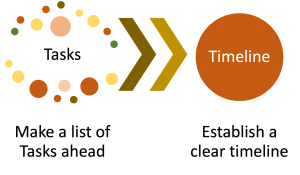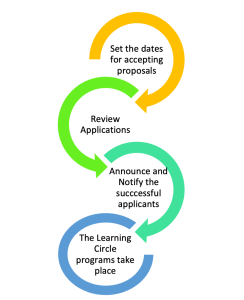2 OER Learning Circle Application Process
Feedback from a Learning Circle Participant:
“My final advice is to join a OER Learning Circle! The peer advice and narratives are invaluable while you create your own OER.”
Jeff Hoover
Fall 2018
 |
| The Learning Circle Application Process. Image created by Giovanni Antunez using Microsoft, Licensed CC BY-SA 4.0 International. |
In the previous chapter we discussed how prior research and past experience have contributed to the identification of some of the most significant barriers to new teacher success, and how these barriers also apply to faculty who are considering OER options for their courses; whether it is to adopt and adapt, or to write their own materials. [1]The OER Learning Circle Model has successfully helped faculty overcome these barriers and supported them in successfully adopting, creating, and remixing OER in their course redesigns and authoring projects. Another unique component of this model is that it provides a method for faculty compensation. [2]
This chapter will discuss how the application process for OER Learning Circles is structured.
The Learning Circle Process begins with an application process. Interested faculty apply to participate, using a grant-style application to explain their proposed work. If selected, they promise to attend all Learning Circle meetings and are paid a stipend for their work. This process can be used either at the institution level or at a system level.[3]
It is important to set up a timeline for a Learning Circle Process. This allows all people involved, both organizers and participants, to know when each step of the process will take place.
Tasks/Timeline
 |
| The work ahead. Tasks/Timeline. Image created by Giovanni Antunez using Microsoft, Licensed CC BY-SA 4.0 International. |
- Establish a clear timeline for OER committee meetings, for the Learning Circle meetings, for the milestones of the Learning Circle process, and assigned responsibilities within the OER committee and the Learning Circles.
- Create the materials and resources needed for the program. This includes creating a LMS site for collecting documents, discussions, collaboration, and assessing final projects.
- Advertise the project to possible interested parties in plenty of time for them to consider participating.
- Set the dates for accepting proposals for the Learning Circle programs, with appropriate application forms provided to all applicants.
- Review the applications using a rubric [4] created by the OER committee (institutional level) or the OER Coordinator and Program Director for Educational Development (System Level), the applications are reviewed and the selection of winning applications is completed, then
andannounce and notify the successful applicants.
- (A percentage of openings can be reserved for Developmental Education faculty.)
 |
| Set the dates. Image created by Giovanni Antunez using Microsoft Word, Licensed CC BY-SA 4.0 International. |
(After a number of season of holding Learning Circles, it may be helpful to have an advance level of Learning Circles for follow-up or Leadership Training)
- The Learning Circle programs take place, with clear accountability for both participation and completion.
- Upon completion of their projects, faculty are paid .5 RCE (Release Credit Equivalency) for their work.
Components of the OER Learning Circle Application
The OER Learning Circle application[5] has two dedicated parts.
In Part A the applicant provides their personal demographics, the type of project they are applying for, their rationale for the value of their project and their pay and fringe benefit information. Part A. Online application form (link to form) that is completed by the applicant.[6]
What are the elements of the application form?
Examples of the content of the application process and rubric to select applicants is included in Appendix A
In Part B of the application the applicant provides the selection committee with their Senior Academic Officer (SAO) name, contact information and their dated signature showing that they are aware of the faculty’s participation and that they are supporting them in their project. Part B. Senior Academic Officer Participation Approval (link to approval form) is completed by the SEO.[7] [8]
See the applications’ revision rubric
A list of documents including the application questions, and the rubric used to score the applications is included also in Appendix A
Applicant Deliverables
Both the applicant and their SAO demonstrate commitment to the project.
Part A. Applicant submits their Online application form by application deadline date.
Part B. Applicant requests approval from their Senior Academic Officer and submits the signed approval form signed and dated from the Senior Academic Officer by application deadline date.
System Office/Institution Process and Deliverables
The system or the institution also has firm commitments and deliverables in the application process.
- Notification of acceptance or denial of applications by (date).
- Letter of acceptance or request for refinement of the project for reapplication are sent to each applicant. (Template included in template section)
- Intra-Agency Agreements, created by the system office and processed for each faculty participant
- Learning Circle Leader welcome letter #1 (email) with polling request to determine common time(s) that all participants are able to meet.

Diagram of System Office/Institutional Process and Deliverables Diagram of System Office/Institutional Process and Deliverables, created by Giovanni Antunez using Microsoft Word, Licensed CC BY-SA 4.0 International. - Learning Circle Leader confirmation letter #2 (email) with polling results and weekly schedule of Learning Circle days and times (same day same time each week for ten consecutive weeks).
- OER Learning Circles will run for ten consecutive weeks for fall and spring semesters and five weeks for summer semester with an additional introductory week for all three sessions ( Beginning Date– End Date).
- OER Project Showcase. (Each participant also signs up for a Final Showcase Event where participants from the three sessions for that academic year share their projects in four one hour sessions, (four different dates and weeks) in April. Each participant creates slides about their project(s) and gives a five minute lightning talk about their project(s). All presenters are available for questions the last fifteen minutes of the session that they chose as their presentation session
Project completed by (date). Examples of recent and previous showcase events can be found at the Academic and Student Affairs at Minnesota State [9] - OER Learning Circle Stipend; For faculty payment, invoices from a college or university business office are submitted to the system office following project completion.
OER Learning Circles Project Application Questions address these elements of the proposed project;
OER Learning Circles Project Application Questions address these elements of the proposed project;
Type of project (Course Redesign, Authoring, Authoring of Ancillary Materials Application)
Explanation of Open Educational Resources
Explanation of Projects Options
Expectations for project completion and content
Key Takeaways
- The OER Learning Circle Model has successfully helped faculty overcome identified barriers to OER adoption and supported them in successfully adopting, creating, and remixing OER in their course redesigns and authoring projects.
- It is important to decide who you will include in the application and acceptance process.
- It is important to outline your operating process. (The one that I describe here is an effective and proven process.)
- It is important to set up a timeline for a Learning Circle Process.
- It is important to create an application form, scoring rubric, and acceptance and notification protocols that reflect the needs and objectives of your institution or system. (Your institution or system may have some nuances objectives that differ from the examples above that need to be considered to make the process work for you.)
- The process I have outlined here is easily adapted to different situations, institutions, and systems.
For more information about the process, contact Karen Pikula at karen.pikula@minnstate.edu
- Pikula, K. (2015). Novice teachers’ perceptions of their ability to transfer teacher education program knowledge to performance in the classroom. Dissertation Research, Educational Psychology,Capella University, from https://www.proquest.com/openview/a7272b00306a5f2fea8c6f8e7e8a31de/1.pdf?pq-origsite=gscholar&cbl=18750 ↵
- Pikula, K. (n.d.). The OER Learning Circle Model. Get Involved in OER, Minnesota state Educational Innovations, from https://www.minnstate.edu/admissions/oer/get-involved/index.html ↵
- Pikula, K. (n.d.). Apply to an OER Learning Circle, Minnesota state Educational Innovations, from https://asanewsletter.org/ ↵
- Pikula, K. (n.d.). Rubric to select FLC applications. OER committee (institutional level) or the OER Coordinator and Program Director for Educational Development (System Level), from -add website information here. ↵
- ASA (Academic and Student Affairs at Minnesota State) Newsletter. (n.d.). OER Learning Circle Applications. From https://asanewsletter.org/event/oer-learning-circle-applications-due-spring-2023/ ↵
- Details of the first section of the application form are included in Appendix Part A ↵
- Details of the second section of the application form are included in Appendix Part B. ↵
- ASA (Academic and Student Affairs at Minnesota State) Newsletter. (n.d.). OER Learning Circle Applications. From https://asanewsletter.org/event/oer-learning-circle-applications-due-spring-2023/ ↵
- ASA (Academic and Student Affairs at Minnesota State) Newsletter. (n.d.). OER project showcase. From https://asanewsletter.org/2023/03/30/2023-oer-project-showcase-how-faculty-are-helping-students-save-money/#more-46265 ↵
The acronym OER stands by "Open Educational Resources"
Adopting an OER (Open Educational Resources) means that an instructor integrates Open Educational Materials into their courses without significant revisions, similar to adopting and integrating any new textbook into an existing course. The difference here is that there is no publisher support when adopting OER. Definition adapted from https://libguides.unm.edu/OER_Primer/adopt_adapt_create
adaptation is a term commonly used to describe the process of making changes to an existing work. We can also replace “adapt” with revise, modify, alter, customize, or other synonym that describes the act of making a change. Always given credit to the author(s) of the previous or original work.
In this case, the instructor is writing its OER (Open Educational Resources) materials using their own experience, or expertise.
the term refers to the process of combining original or revised content with other OER to create something new.
The Learning Circle (LC) Model and Process were created to allow participants to be met where they are in the learning process. The author sometimes uses only the words 'model' or 'process' and sometimes both.
The acronym stands for the "Senior Academic Officer (SAO)"
